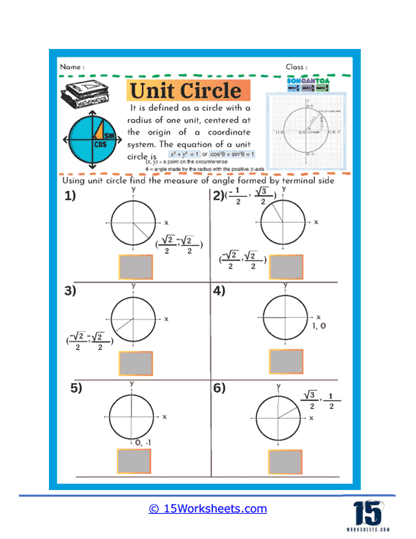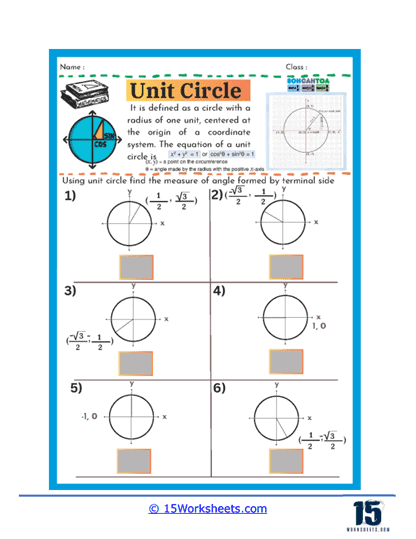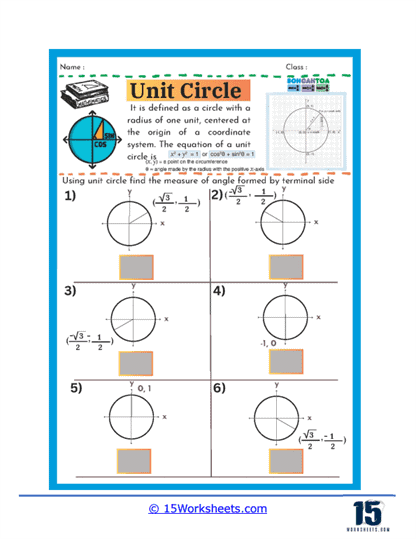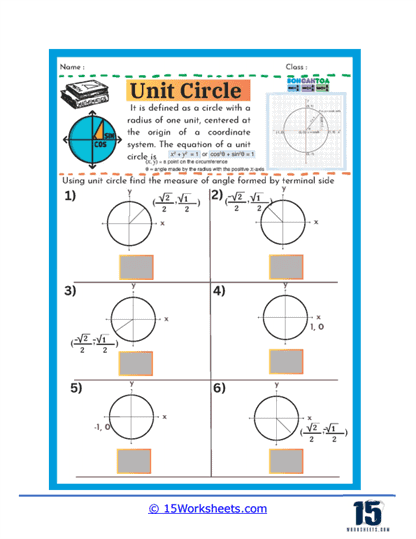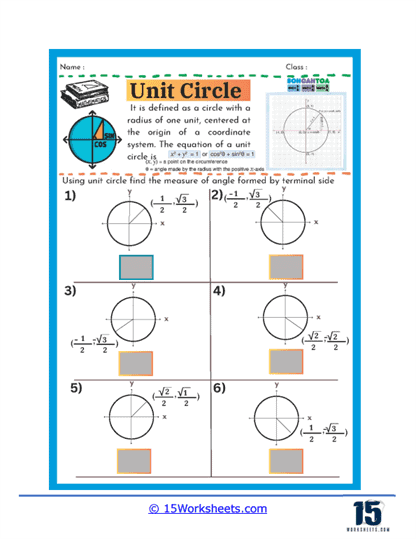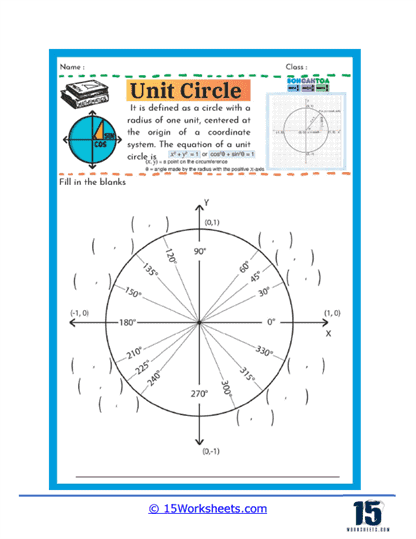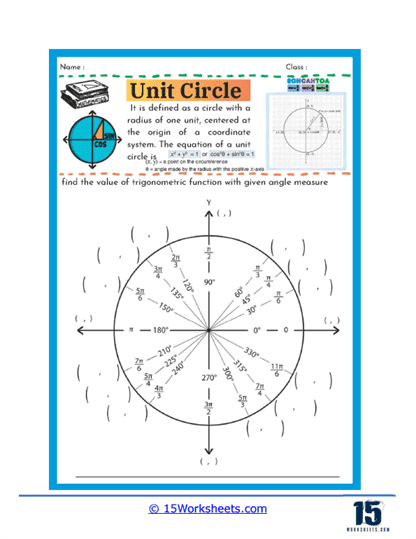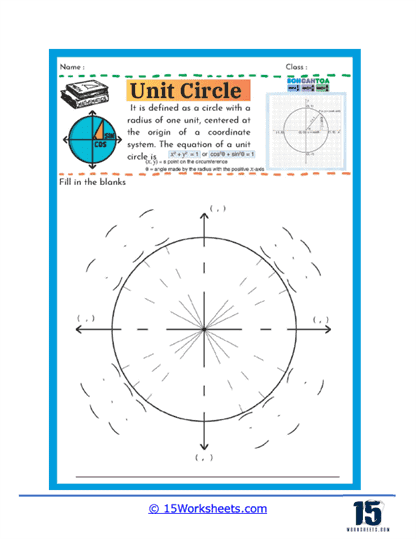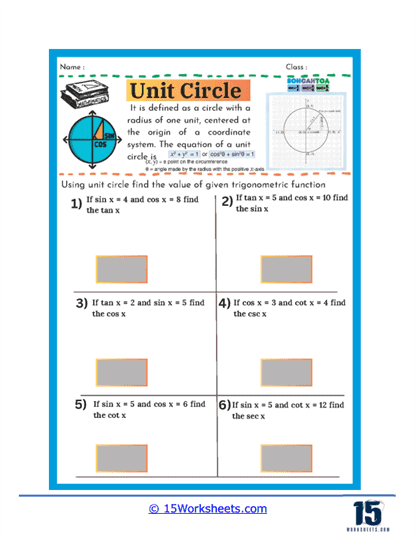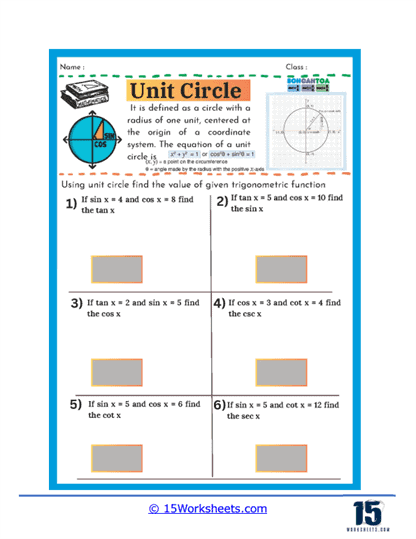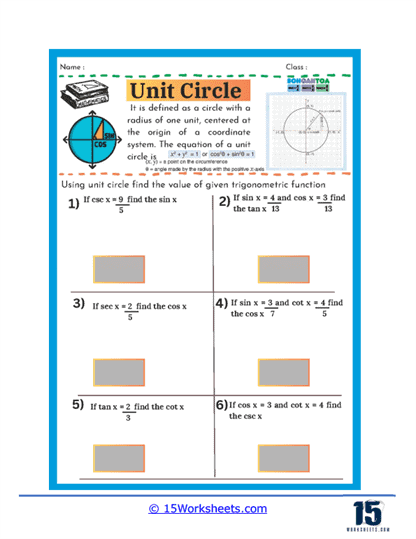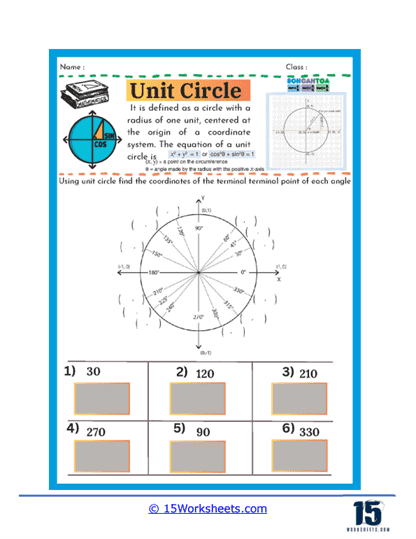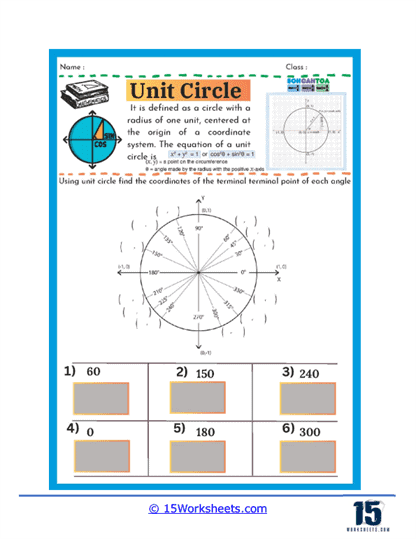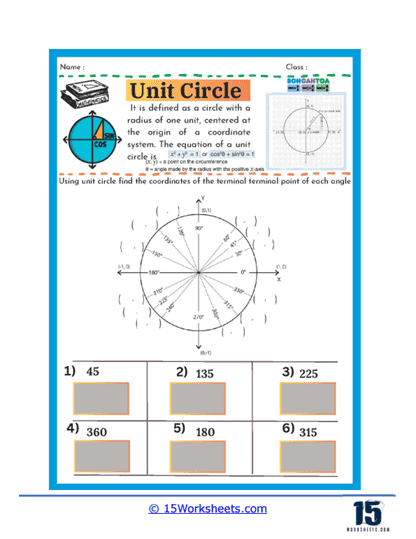Unit Circle Worksheets
About These 15 Worksheets
This series of worksheets will help students learn the fundamental concepts of trigonometry, particularly those related to the unit circle. These worksheets provide a structured approach to understanding how angles, radians, and trigonometric functions are interconnected on a circle with a radius of one unit. The worksheets often present students with various types of exercises, each designed to reinforce specific skills and concepts related to the unit circle.
One common type of exercise found on these worksheets involves identifying the angles formed by the terminal side of a given point on the unit circle. In these exercises, students are provided with the coordinates of a point, and they must determine the corresponding angle, typically measured in degrees or radians. This activity helps students solidify their understanding of the relationship between the coordinates on the unit circle and the angles they represent, which is a foundational concept in trigonometry.
Another type of exercise focuses on finding the exact values of trigonometric functions, such as sine, cosine, and tangent, for specific angles on the unit circle. These worksheets require students to apply their knowledge of the unit circle to identify the correct values based on the given angle. This reinforces the memorization and application of key trigonometric identities and helps students become more comfortable with evaluating these functions at standard angles.
In addition to these basic exercises, some of the worksheets challenge students to find the coordinates of the terminal point of an angle on the unit circle. These exercises often involve working with angles in different quadrants, requiring students to apply their understanding of how the sign of the coordinates changes based on the quadrant in which the angle lies. This deepens their comprehension of the symmetry and properties of the unit circle.
Some of the worksheets combine trigonometric functions with algebraic expressions, asking students to find the value of a trigonometric function when given an equation involving sine, cosine, or tangent. These problems typically require students to solve for the variable using their knowledge of the unit circle and trigonometric identities. This type of exercise is particularly useful for developing problem-solving skills and for preparing students for more advanced topics in trigonometry and calculus.
They guide students through the process of connecting angles, radians, and trigonometric functions to the unit circle, providing ample practice opportunities to master these essential skills. Whether students are identifying angles, evaluating trigonometric functions, or solving equations, these worksheets offer a valuable means of building a strong foundation in trigonometry. Through consistent practice and application, students gain confidence in their ability to navigate the unit circle, ultimately preparing them for more complex mathematical challenges.
What is the Unit Circle?
The Unit Circle is unique because it simplifies the relationship between angles and trigonometric functions. Every point on the Unit Circle can be described using an angle, usually denoted by the Greek letter theta (θ), which is measured from the positive x-axis. This angle can be measured in degrees (ranging from 0° to 360°) or in radians (ranging from 0 to 2π). In the Unit Circle, the coordinates of any point on the circle are given by (cos θ, sin θ). This means that the x-coordinate of any point on the circle corresponds to the cosine of the angle θ, and the y-coordinate corresponds to the sine of θ.
For example, at 0° (or 0 radians), the point on the unit circle is (1, 0), meaning cos(0°) = 1 and sin(0°) = 0. At 90° (or π/2 radians), the point is (0, 1), meaning cos(90°) = 0 and sin(90°) = 1. This pattern continues around the entire circle, providing a complete map of sine and cosine values for every angle. Additionally, because the radius of the Unit Circle is 1, the hypotenuse of any right triangle formed by drawing a perpendicular from any point on the circle to the x-axis is also 1. This simplifies calculations involving trigonometric ratios, making the Unit Circle an essential reference for trigonometry.
How is the Unit Circle Used in the Real World?
The Unit Circle is not just a theoretical construct; it has practical applications in numerous fields that impact our daily lives. Here’s a look at how the Unit Circle is used in the real world:
1. Navigation and GPS Technology
The Unit Circle is crucial in navigation systems, including GPS technology. When determining a location on the Earth’s surface, trigonometric functions are used to calculate distances and angles relative to a fixed point, often the Earth’s equator or a prime meridian. The sine and cosine functions derived from the Unit Circle help in converting these angles into meaningful geographic coordinates that can be used to pinpoint locations on maps and guide us from one place to another with precision.
2. Waves and Oscillations
The Unit Circle is deeply embedded in the study of waves and oscillations, which are phenomena that occur in various fields such as physics, engineering, and even music. For example, sound waves, light waves, and electromagnetic waves can all be modeled using trigonometric functions based on the Unit Circle. In these cases, the angle θ can represent time or position, and the sine or cosine functions describe how the wave oscillates. Engineers use these models to design everything from radios and cell phones to medical imaging devices and noise-canceling headphones.
3. Engineering and Signal Processing
Engineers rely heavily on the Unit Circle when analyzing and designing systems that process signals, such as communication networks, audio and video systems, and radar. In these systems, signals are often represented as sinusoidal functions (sine and cosine waves), which can be directly tied back to the Unit Circle. The frequency, amplitude, and phase of these signals can be manipulated to transmit information, remove noise, or enhance certain features of the signal. The Unit Circle provides a framework for understanding and controlling these aspects.
4. Robotics and Computer Graphics
In robotics and computer graphics, the Unit Circle is used to model and control the movement of objects. For example, when programming the motion of a robot arm or the animation of a character in a video game, developers use trigonometric functions to calculate angles and distances. The sine and cosine values from the Unit Circle determine the direction and speed of movement, ensuring smooth and accurate operations. This application is critical in fields ranging from industrial automation to entertainment.
5. Architecture and Construction
Architects and builders use the principles of the Unit Circle to design structures and ensure they are stable and aesthetically pleasing. When designing curved elements, such as arches, bridges, or even domes, trigonometric functions derived from the Unit Circle help calculate the necessary dimensions and angles. This ensures that the structures can withstand forces like gravity and wind while maintaining their intended shape and function.
6. Astronomy and Space Exploration
The Unit Circle is also instrumental in astronomy and space exploration. Astronomers use it to calculate the positions of celestial bodies, predict eclipses, and navigate spacecraft. The circular orbits of planets, moons, and satellites are analyzed using trigonometric functions, with the Unit Circle providing a simple way to understand and predict the movement of these bodies in space.
Its role in trigonometry allows us to model and solve problems involving angles and distances, making it indispensable in fields as diverse as navigation, engineering, robotics, architecture, and even astronomy. The Unit Circle’s simplicity and versatility make it a cornerstone of both theoretical and applied mathematics, with practical implications that touch nearly every aspect of modern life.


